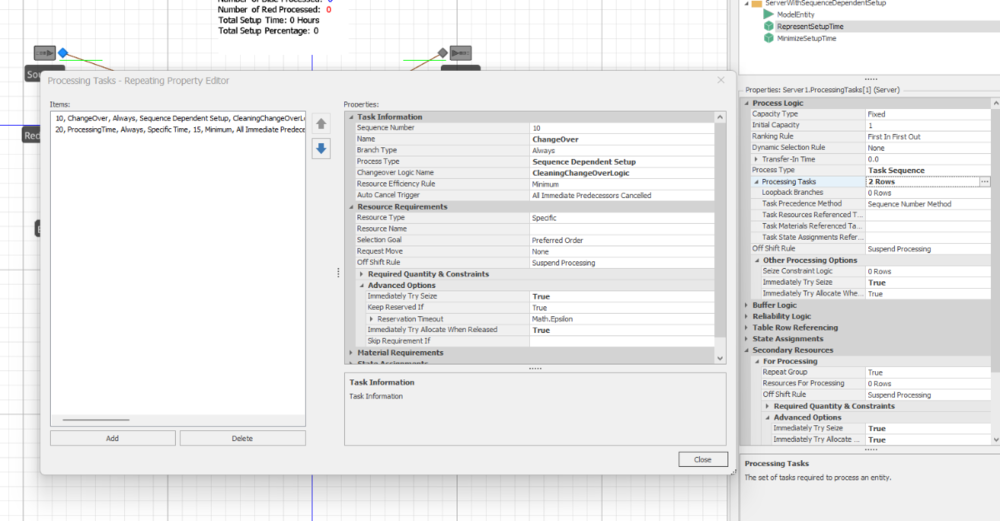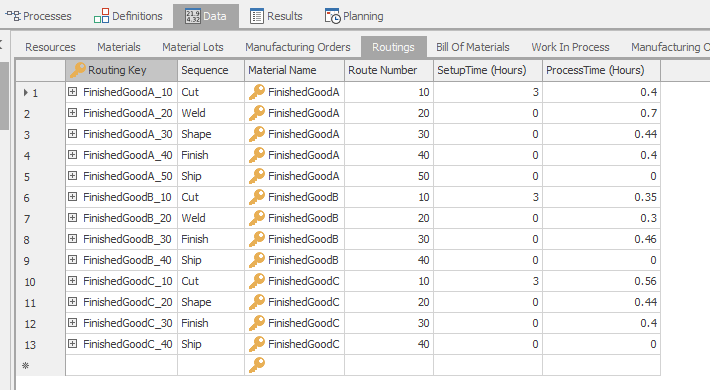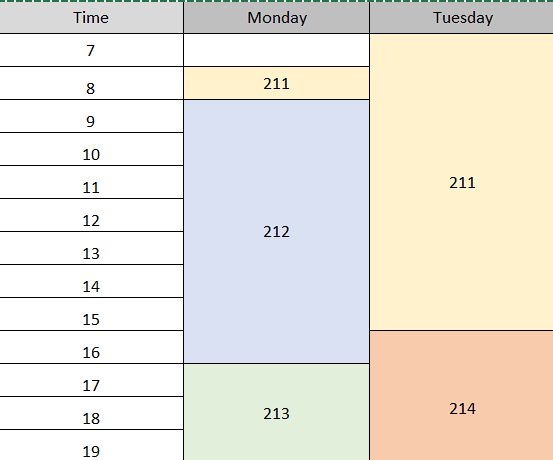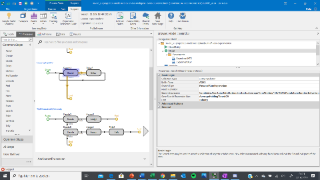Search the Community
Showing results for 'process time depending on entity count'.
-
How can I model where the robot always pick 2 parts and waits until 2 parts are available at output buffer of the server. (Robot is available in extras library). i have multiple servers in the model.
-
Hey, I've got a quick question on how to route to a combiner with the longest waiting time in their parent queue. I think it should be quite easy, but i cant seem to make it work. What i have been doing is setting the selection goal of my routing node to largest value, and select from a list. This largest value I think should be the the longest waiting time in the contents of the parentinput queue. I have tried this multiple ways both using assosiated object and without. When i recall the number waiting it seems to work, but with recalling the waiting time i'm doing something wrong. My current expression is: Candidate.Node.AssociatedObject.Combiner.ParentInputBuffer.Contents.TimeWaiting(ModelEntity) or Candidate.Combiner.ParentInputBuffer.Contents.TimeWaiting( object ) both seem to work for content.numberwaiting. I think i am describing the ( object ) part wrong but cant find how i should write for the modelentity otherwise. I have tried to recall a specific entititype like so --> TimeWaiting(Truck) this also does not work. Does somebody know how i can acces the ParentInputBuffer.Contents.TimeWaiting? Greeting Piet
-
Perhaps its a little late, but attached is a possible solution to your problem. This started out pretty simple. The problem was how to specify which server is serviced by which resource. One way to do that is a table. But since its changing over time I chose to use a time-indexed table, that is a table that knows about time and returns different data at different times. In this case, each row corresponds to 12 hours and each column specifies the resource needed by the respective server. As they say, "the devil is in the detail" and in this case the "devil" is that the specified resource may change between seize and release (e.g., seize at 11:59, release at 12:05). Simio doesn't like that and all the easy options re-evaluate the resource expression on release and so may try to release the wrong resource. One option would have been to create a custom server, but that seems to be overkill. Here is a somewhat simpler approach: 1) Add an entity state named MyResource and assign it at the last possible moment before use. This value will be used only for release. The assigned value is drawn from the table using an expression like Table1.S1Resource.TimeIndexedValue.Object. Note that the .timeindexedvalue indicates to get the value associated with the current time. And the .object at the end is used to tell Simio to return that value as an object not a number. 2) Use Secondary Resources - Other Resource Seizes to seize the name specified in the table using the same expression above Table1.S1Resource.TimeIndexedValue.Object. 3) Use Secondary Resources - Other Resource Releases to release the resource saved in MyResource. TimeBasedWorkerSelection.spfx
-
I can't say enough good things about working for McDonald's. If you'd like to join in on the fun and work on simulation and process improvement projects that have an impact around the world--for one of the most recognized brands in the world--you might check out this opportunity... McDonald's Corporation Supervisor Process Design and Simulation | SmartRecruiters
-
Hi! can you help me please? In my model I have a server that I want to function as storage, this server is linked to a combiner which will combine the member entities that leave the server with a parent entity that will arrive at it from another node. Each member entity has a state with a unique number linking it to a parent entity (there may be more than one member entity with the same state number). How can I extract from the server only the member entities whose state is equal to the state of the parent entity that arrives at the parentinput of the combiner? Thank you so much! 18.10.spfx
-
Hi! In my model I have entities called "Pedido" which have a state called "id_del_pedido" which is equal to the ID of the entity. These entities will enter a Separator that will create copies of the entity according to a probability distribution. Since the new entities are copies of the parent entity, they will have the same "id_del_pedido" status as the parent entity. Subsequently, the entities created will enter a Server that acts as a warehouse. This Server is linked to a Combiner, when the parent entity reaches the Combiner's parentinput I want only entities whose "id_del_pedido" is equal to the ID of the entity that reached the Combiner's parentinput to leave the server. This works perfectly in the first Server-Combiner set of my model, but, the Combiner's outputnode is attached to another Combiner and I want to repeat the same activity as in the first Combiner but I get an error that I don't know how to solve. I attach my model so that my problem is better understood. Thank you very much in advance! 18.10.spfx
-
Hello Everyone, please can someone help me with this situation? I want to use a Server as a storage place, entities coming out of it go into the MemberInput of a Combiner. I want the number of entities that leave the Server to depend on the state of the entity that will enter the ParentInput of the Combiner. How can I access the state of the parent entity that will enter the combiner from the Output Node of the Server? Thank you very much, Greetings! 14.10.spfx
-
Hello, I'm having strugles trying to configure the setup for the next process: some entities have a diferent processing time and setup time, before to enter to be processed in the workcenters, the workcenter have to be cleaned. I looked the simbit, "ServerWithSequenceDependenrSetup" but I'm confused with the configuration of the processing task. I dont know why we have two lines and o why only one have associeted the change-over matrix.
-

Changing Sequence table over time
Rebecca Obasi replied to antonio6vieira's topic in SI General Discussions
That's because there is a routing table in this case. That's how it was set in this simbit before I made the updates. I also I tried to set the "Routing Table" as the initial sequence for the entity and I'm still getting the same error. -
I wonder if it is possible to pick one particular entity from the BatchMembersQeue and unbatch it. For example I have a pallet with 10 entities batched (9 red and 1 blue) and I want to remove only the blue one. I was able to find the entity with a search step, but I cannot transfer it or unbach it. Any ideas? TnksUnbatch one entity.spfx
-
Job Description Energetic and personable professional who applies operational research to best utilize workforce, data, technology, and other resources to achieve maximum productivity within budgetary constraints. Guides current practices and facilitates through more efficient and effective ways to achieve operational excellence. Experience in discrete event simulation, agent-based modeling, and predictive analytics is a plus Job Responsibility Develops metrics, creates dashboards, reports, and identifies areas of improvement across the organization using various analytical tools and techniques. Identifies current process gaps through the use of observations, data collection, data analysis, process ideologies and communication with management and frontline staff. Identifies issues, root causes, strategies for improvement, and development of implementation and sustainment plans. Supports project management, development of project timelines, and follow-up action items for process improvement initiatives. Develops the summary of findings, recommendations, and action plans to management. Applies principles, techniques and procedures to the design and implementation of technology and process solutions (i.e. Lean, Six Sigma, Kaizen). Supports development of principles and methods for curriculum and training design, teaching and instruction for individuals and groups, and the measurement of training effects. Work assignments are varied and require interpretation and independent decisions on the course of action. Decisions may be guided by precedent, previous experience, and known professional guidelines and compliance requirements. Often required to interpret policies, standards, requirements, and approaches to meet work objectives. Regularly exercises independent judgment on matters of significance within defined procedures to determine appropriate actions/approaches. Normally receives general instructions on routine work, and detailed instructions on new projects or assignments. Performs related duties as required. All responsibilities noted here are considered essential functions of the job under the Americans with Disabilities Act. Duties not mentioned here, but considered related are not essential functions. Job Qualification Bachelor’s Degree or equivalent combination of education and related experience as Continuous Improvement Engineer, Industrial Engineer, Operations Process improvement Engineer, Process Engineer, or Lean Six Sigma Black Belt. 1-3 years of technical experience, required. Technical Skill preferred: Experience in discrete event simulation (preferably Simio), Lean, Black Belt Six Sigma Certificate, Statistical Analysis, Graphical Analysis, Facilitation, and Presentation Skills, Operational Research, Programing (i.e., R or Python), Predictive Modeling, Agile Project Management. Here is the link to apply: https://jobs.northwell.edu/job-3/16580688/process-improvement-engineer-lake-success-ny/
-
Hi, everyone I am developing a postgraduate project related to hospital OPD simulation. In one examination room, there will have a round 5 to 6 doctor using this room during the week. Now I am facing one problem, because every doctor process have difference processing time(function) as picture below(The number is doctor ID). Is there any method to set a difference process time during every shift in one server? or I have to create a process for this them?
-
there are several easy ways to do this. 1) Subclass the Resource or Worker object with the only change is to add a property or state (ex PTime) to hold the processing time specific to that resource. 2) Put your process times in a table and reference the correct table row for the doctor that is working. The SimBit WorkerPoolWithEfficiency does something somewhat similar.
-
Hi, I'm having trouble with unit conversion when doing state assignments at a source. There are two different cases where this problem appears in the model: Subtracting TimeNow minus a Date Time state variable (ModelEntity.stWaitingListEntryDate) Although the specified unit for this property is 'Days', the assigned value is in hours and the unit is also 'Hours'. If I manually convert it by dividing by 24, the assigned value is in days, but the displayed unit is still ‘Hours’. Unit conversion issue when assigning a new value to a state variable from a data table Although the PatientsData.MaxWaitingTime is a real property with default unit ‘Days’, the assigned value to the state variable is converted to ‘Hours’. As in the first case, if I manually convert it by dividing by 24, the assigned value is in days, but the displayed unit is still ‘Hours’. In the attached model (time_units_conversion.spfx) you will find a simple example where you can see this in more detail. Any suggestions to solve this issue will be highly appreciated. Thank you and best regards, Nicolina
-
- state variable
- state assigments
- (and 8 more)
-
Hi All I would like help to build a custom (subclassed) node that, OnInitialized, would populate a lists of inbound and outbound path in each node. Ideally, it would also determine and store each path's length or travel time, and whether the path is available or not (this would probably require a subclassed path as well). I want this done dynamically (automatically) because I will likely have hundreds of nodes in my model and populating (and re-populating) these lists would be very time consuming and not very conducive to an efficient design process where paths and nodes would be added/subtracted throughout the design process. First, I guess, actually...is dynamic list population possible? Any thoughts? Thanks
-
A basic photo eye object that can be used with conveyor belts. Photo eye is based on a transfer node object. It collects statistics on time in blocked state, cleared state and throughput. Transfer nodes on entered and on exited add on processes can be used as on blocking and on clearing add on processes. Photo eye has properties to define the delays for on blocked and on cleared. Photo eye will wait to complete on blocked delay to execute on blocked add on process. Similarly, photo eye will wait to complete on cleared delay to execute on cleared add on process. PE_Library.spfx
-
Dear Simio employee, I have two questions about 'getting' the average holding time for all the realisations of my subclassed vehicle. I want to know how long an entity is on a vehicle, on average. I tried it with two processes, but both don't work. I don't understand why the following doesn't work (process GemTijdOpAGV): And I also don't understand why the process TijdContainerOpVoertuig doesn't work. I don't understand the error: 'Model Entity does not match the model', or something like that. I created two instances of de model entity, named 'container and pallet', but it seems like I can't use model entity in some processes and in others I can. Why is that and when can you use model entity and when not? (This is also true for instances of a vehicle.) I have attached the model below, but it is still in progress. I hope to hear from you soon! With kind regards, Thomas Haven_v1 project DS model met RS en dus intelligent MTS.spfx
-
Hi, I want to generate one type of product with one interarrival time. I have one source and one model entity. However, this entity can have different lengths following probabilities. Depending on these properties, the processing times at the servers will be shorter or longer. I tried to assign a state to the entity before this entity exits the source so ModelEntity.Length becomes DataLength.prob.randomrow. where DataLength is a table with the different lengths and the probabilities associated with those Lengths. The only thing is that it is a property and not a state, but I do not know how to do it in another way. Afterwards, I have different processing times at the servers depending on the different characteristics of my entity. For example, server1 will have different processing times depending on the length. How can I reference to the good processing time say I have added a column to the table DataLength with the associated processingtimes according to the lengths? Finally, I would also like keep track of those different lengths generated and see what the model produced in the end. Thank you for your help, Emilie
-
I know it's been a while, but I just came across this question and I'm responding in case this can help someone else. Depending on the problem, modeling nurses as patient capacity might not work; for example, if you need to limit both a nurse's active utilization and the nurse's patient load. Two general approaches exist: Easier: Create two different resources, rename one 'NursesActive' and the other 'NursesPassive.' Set the latter to have n times the capacity of the former, where n is the patient ratio at n:1. Require simultaneous seizure of one of each type of resource when first assigning the patient, and release them separately, re-seizing the former as needed. Harder: Subclass the Resource object and create states to track the patients assigned and a property to define the patient ratio. This approach enables more fine-tuning as necessary.
-
Hi, everyone Hi, everyone I am developing a postgraduate project related to hospital OPD simulation. After collecting each table/room process time, convert all the data into an Excel sheet. I am curious is SIMIO has any tool to analyze the best-fit function from the data (time related) I gathered. Thanks.
-

Changing Sequence table over time
Rebecca Obasi replied to antonio6vieira's topic in SI General Discussions
I used the "DashboardForScheduling" simbit as an example for this case. For the order that is using "FinishedGoodA" material, I want to change the sequence after the welding process is complete if both shape stations are not available. So, I created an alternative sequence table and referenced in the process logic I created. Whenever this happens, I get same type of error message. Do you think this is happening because the normal routing table is referenced at the source object? -
Greetings, I would like to express the following condition in the Decide step but i couldn't find how; Run.TimeNow - ModelEntity.TimeCreated< 60 (minute) Could you please tell me how to express correctly the 60 minutes ? Best regards,
-
I'm interested in calculating a yearly production rate. Essentially I could do this if I ran my simulation for 1 year and looked at the output. The number of entities destroyed by my "completed" sink will be what I'm looking for. How do I determine this value if I'm running for longer than 1 year? For example; If I run for 5 years, and I'm watching my model run, at week 186 I'd like to know how many entities had been destroyed by my "completed" sink between weeks 134 and 186 to determine my yearly production rate.
-

Changing Sequence table over time
Rebecca Obasi replied to antonio6vieira's topic in SI General Discussions
Ok I can do a trace and see what I find. Also, I do have different entity/job types getting processed. In my routing tables, I do have the entities specified in the table. I'm trying to use the "ChooseAlternateSequence" simbit as a reference. Is it possible to do this if you have more than one entity type? -
https://jobs.arup.com/jobs/aviation-analyst-9522 Arup is proud to be recognized by Fast Company in their third annual Best Workplaces for Innovators list, which honors businesses and organizations that demonstrate a deep commitment to encouraging innovation at all levels. We find solutions for some of the world’s most complex problems. From climate action to social value, we consider the broadest impacts of our work. We strive to build a more sustainable, resilient, and equitable future. This purpose shapes our culture and has made us leaders in sustainable development. You’d be joining our multi-disciplinary design teams focusing on technical excellence and innovative solutions that create a better future for people, places, and the planet. Start Here, Go Anywhere! Want to work for a company that invests in innovation and people who catalyze impact in the built environment? Arup is proud to be recognized by Fast Company in their third annual Best Workplaces for Innovators list, which honors businesses and organizations that demonstrate a deep commitment to encouraging innovation at all levels. We find solutions for some of the world’s most complex problems. From climate action to social value, we consider the broadest impacts of our work. We strive to build a more sustainable, resilient, and equitable future. This purpose shapes our culture and has made us leaders in sustainable development. You’d be joining our multi-disciplinary design teams focusing on technical excellence and innovative solutions that create a better future for people, places, and the planet. During your career at Arup, you’ll have the chance to engage in a fulfilling career and work with some of the most highly respected engineers and specialists in the world. You’ll also get the opportunity to work on exciting and significant projects, delivering quality work that has a positive and lasting influence on the community and the environment. Responsibilities of this specific role will include, but not be limited to the following: • Perform capacity/demand assessment for planning studies using various tools, methods and techniques • Conduct passenger and baggage flow simulation modelling, interpret results and identify solutions • Develop spatial requirements and program development for infrastructure and facilities planning • Undertake data driven analysis to gather insights including research-based projects • Assist with development of automation tools using programming languages • Assist with development and review of forecast demand • Collect and collate data from surveys, benchmark studies and other sources as needed in support of planning studies • Assist in preparation of reports, presentations and deliverables including illustrations, tables and drawings to communicate complex technical ideas through a graphical and visual approach for a wide range of clients • Generate and contribute to planning and operational reports and provide advice to planning and design teams, airports and airline clients • Project work includes many of the most significant complex airport developments globally • Some travel may be required in the longer term Qualifications Required: • Bachelor’s degree (Master’s degree preferred) in Civil/Industrial/Operations Research/Transport engineering or other relevant disciplines • 2-5 years of increasingly responsible experience in airport planning and analysis • Knowledge/experience of analytical techniques and tools applied in airport planning including spreadsheet, database and simulation software such as Simio, CAST or others • Python or R or similar programming skills preferred • Proficiency in Microsoft Office applications (Word and PowerPoint); advanced Excel user • Demonstrated strong numeric analytical competence and strategic thinking capability • Good written and verbal communication skills essential for team-based working • Excellent planning and organization skills and attention to detail for our fast-paced environment • Must be highly motivated, proactive and willing to take on new challenges Arup is the creative force at the heart of many of the world's most prominent projects across our industry. We offer a broad range of professional services to clients around the world that combine to make a real difference to our clients and the communities in which we work. Notable Projects: • Toronto Pearson International Airport • Montreal Trudeau International Airport • New York John F. Kennedy International Airport • Chicago O’Hare International Airport • Los Angeles International Airport • Istanbul International Airport • London Heathrow International Airport • Singapore Changi International Airport Benefits that Work - At Arup, we have a comprehensive and valuable benefits program that works for our employees and their families. These are 100% paid for by Arup expect for optional life insurance. These benefits provide health and welfare security for you as well as paid time off for rest and renewal. Our Global Profit Share Plan (paid bi-annually) provides an opportunity for you to share in the success of the Firm. As a valued employee of Arup, you can also choose to participate in our GRRSP 5% company match to help you save for your future. COVID-19 Vaccination Requirement - Arup requires all new employees to be vaccinated for COVID-19. Arup is an equal opportunity employer and consistent with federal, state, and local requirements, will consider requests for reasonable accommodation based on disability or sincerely held religious beliefs where it is able to do so without undue hardship to Arup. Flexible Working - We believe that flexible arrangements create a more inclusive way of working that supports our diversity and the wellbeing of our people. Options for alternative schedules and the ability to work outside of the office for a portion of your workweek are available. Arup is an Equal Opportunity Employer. We consider all qualified candidates regardless of national origin, veteran, disability, sixual orientation, gender, gender identity or other status protected by law. If you need any assistance or accommodations due to a disability, please contact us at americasbenefits@arup.com. For the fourth consecutive year, Arup has been named one of Greater Toronto’s top employers! Greater Toronto’s Top Employers for 2021 are recognized for exceptional human resources programs and forward-thinking workplace policies. Find out more about what makes our Toronto office an outstanding place to work here: https://bit.ly/2B3QYL8
















